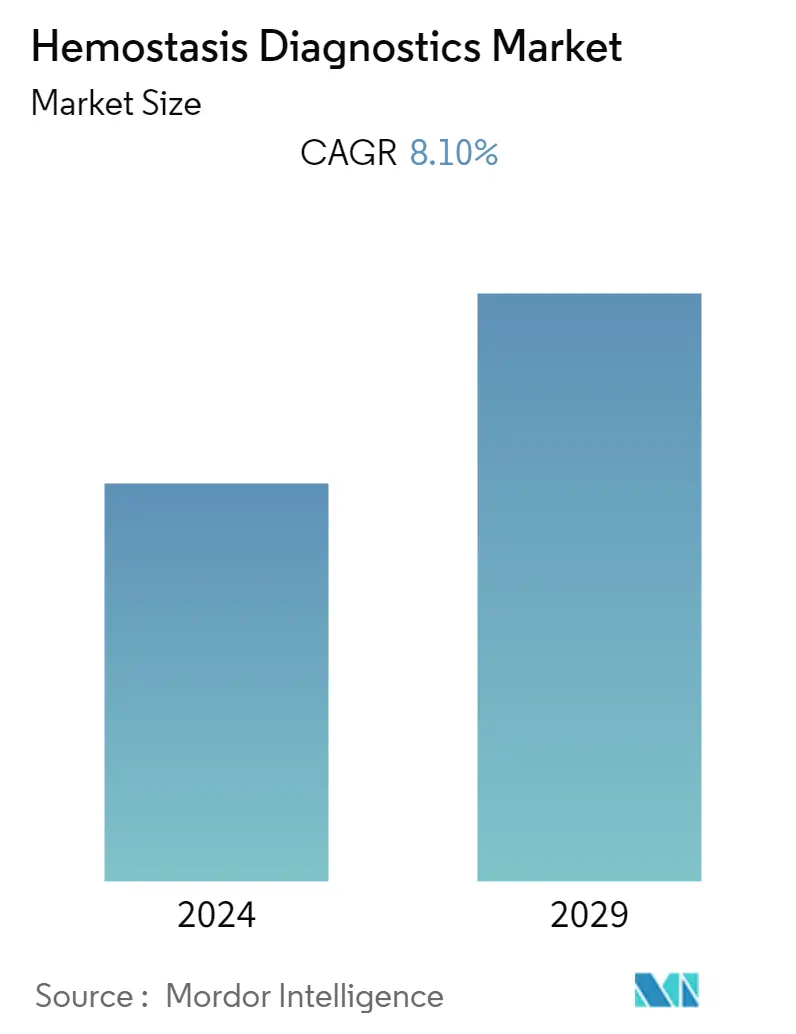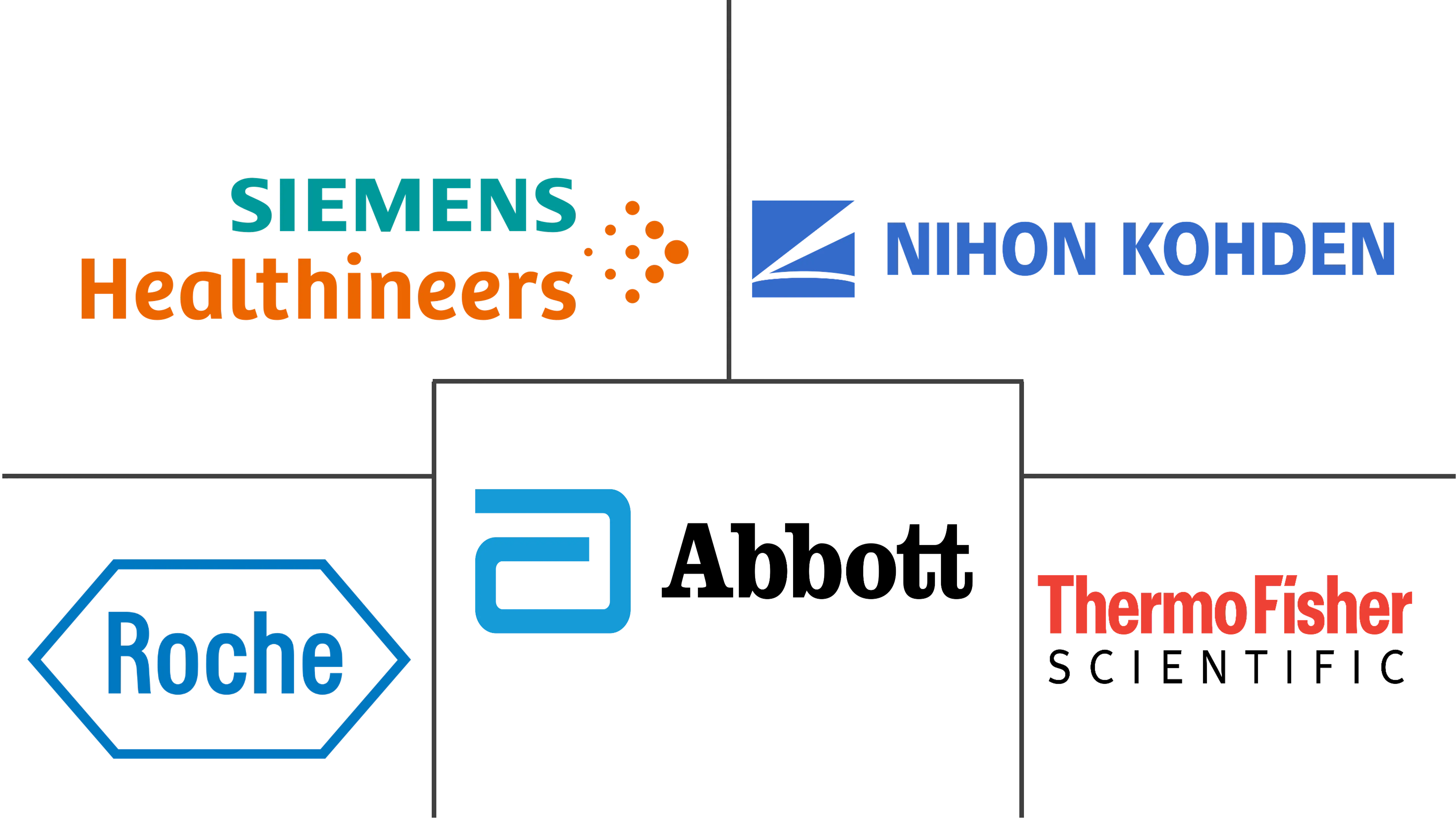Market Size of Hemostasis Diagnostics Industry

| Study Period | 2019 - 2029 |
| Base Year For Estimation | 2023 |
| CAGR | 8.10 % |
| Fastest Growing Market | Asia Pacific |
| Largest Market | North America |
| Market Concentration | Low |
Major Players
*Disclaimer: Major Players sorted in no particular order |
Hemostasis Diagnostics Market Analysis
The hemostasis diagnostics market is expected to grow at a CAGR of 8.1% over the forecast period.
COVID-19 had a significant impact on the studied market owing to the high utility of point-of-care diagnostic tests and various hemostasis tests in COVID-19-admitted patients with other comorbidities like diabetes or cardiovascular diseases. For instance, according to a research article published in the PLOS One Journal in October 2021, elevated D-dimer is used to predict the severity of SARS-CoV2 infection. Hence, 129 patients underwent a D-Dimer assessment following COVID-19 recovery. D-dimer elevation was found in 15% and was significantly more common in patients who had experienced a severe COVID-19 infection that had required hospitalization compared to patients with mild disease. Therefore, growth was observed in the utility of hemostasis diagnostics during the pandemic. In the current scenario, the hemostasis diagnostics market is growing because of the rising number of surgical procedures which require these tests as a routine assessment of the preoperative patient hence market is expected to show a stable growth rate during the forecast period.
In addition, the rising incidences of blood clotting disorders, technological advancements for medical treatment, and rising adoption of automated hemostasis equipment are actively affecting the growth of the studied market.
As per a World Bleeding Disorders Registry 2021 report, the survey of 37 countries reported 9,414 people with hemophilia as of December 2021, the high prevalence was reported in South-East Asia with 2,828 affected individuals, followed by Eastern Mediterranean and Africa with 2,418 and 1,027 individuals. Out of the total cases, 7,943 were of hemophilia A and 1,428 were of hemophilia B. As hemostasis diagnostics is crucial in detecting various types of hemophilia, the market is expected to grow with the high burden of cases.
Furthermore, an article published in eJIFCC in June 2021 stated that in most developing countries, point-of-care technology is delivered in remote locations or physicians' chambers or hospital setups of emergency rooms, operation theaters, and ICUs. It is applied for therapeutic aid, preventive measures (for targeted screening in high-risk groups), or surveillance measures (monitoring of routine blood parameters). The rising demand of point-of-care testing and other diagnostic tests for hemostatis diagnostics is further projected to propel the market growth.
Also, initiatives undertaken by market players to advance the development of hemostasis diagnostics leading to product launches, and partnerships are contributing to the market growth. For instance, in February 2021, Sysmex Corporation and Siemens Healthcare Diagnostics Inc. extended their strategic agreement to work together on global supply, distribution, and sales and service for hemostasis products through at least 2023. The partnership enabled one of the largest portfolio of hemostasis systems and reagents in the world to continue to be available to laboratory customers worldwide.
Therefore, owing to the aforesaid factors such as high burden of hemophilia worldwide, research studies for the advancement in hemostatis diagnostics and strategic initiatives by market players to strengthen their market position, the studied market is anticipated to witness growth over the analysis period. However, a lack of awareness regarding hemostasis disorders in underdeveloped regions and stringent government regulations may restrict the market.
Hemostasis Diagnostics Industry Segmentation
As per the scope of the report, hemostasis diagnostics are those devices that help in the identification of hemostatic defects which leads to excessive bleeding. Hemostasis is a mechanism followed by the body after getting injured, it slows down blood loss and stops blood flow. Hemostasis helps in the diagnosis of the actual cause of these disorders with history and helps in the treatment. The Market is Segmented By Product (Laboratory Analyzers (Automated Systems, Semi-automated Systems, and Manual Systems), Point-of-Care Testing Systems), Test (Activated Partial, Thromboplastin Time, D Dimer Test, Fibrinogen Test, Prothrombin Time (PT) Test, and Other Tests), End-Use (Hospitals, Diagnostic Centers, and Others) and Geography (North America, Europe, Asia-Pacific, Middle East and Africa, and South America). The market report also covers the estimated market sizes and trends for 17 different countries across major regions, globally. The report offers the value (in USD million) for the above segments.
| By Product | |||||
| |||||
| Point-of-Care Testing Systems |
| By Test | |
| Activated Partial Thromboplastin Time | |
| D Dimer Test | |
| Fibrinogen Test | |
| Prothrombin Time (PT) Test | |
| Others |
| By End User | |
| Hospitals | |
| Diagnostic Centers | |
| Others |
| Geography | ||||||||
| ||||||||
| ||||||||
| ||||||||
| ||||||||
|
Hemostasis Diagnostics Market Size Summary
The hemostasis diagnostics market is poised for significant growth, driven by a combination of factors including the increasing prevalence of blood clotting disorders and the rising number of surgical procedures necessitating routine preoperative assessments. The market's expansion is further supported by technological advancements in medical treatments and the growing adoption of automated hemostasis equipment. The COVID-19 pandemic highlighted the critical role of hemostasis diagnostics, particularly in patients with comorbidities such as diabetes and cardiovascular diseases, thereby boosting the market's utility. The demand for point-of-care testing, which offers rapid and reliable diagnostic results, is also on the rise, especially in emergency and intensive care settings. Strategic initiatives by key market players, including partnerships and product launches, are contributing to the market's robust growth trajectory.
North America is expected to maintain a significant share of the hemostasis diagnostics market, driven by the high adoption of advanced automated analyzers and a large patient pool with a high prevalence of blood clot disorders. The region benefits from collaborations between government organizations and market players, which are fostering research and development in hemophilia diagnostics. The competitive landscape is characterized by the presence of both international and regional companies, with major players like Abbott, Sysmex Corporation, and Thermo Fisher Scientific Inc. actively participating in the market. Recent advancements, such as the FDA clearance of innovative hemostasis systems, underscore the ongoing technological progress and strategic efforts to enhance market position and growth.
Hemostasis Diagnostics Market Size - Table of Contents
-
1. MARKET DYNAMICS
-
1.1 Market Overview
-
1.2 Market Drivers
-
1.2.1 Rising Incidences of Blood Clotting Disorders
-
1.2.2 Technological Advancements for Medical Treatment
-
1.2.3 Rising Adoption of Automated Hemostasis Equipment
-
-
1.3 Market Restraints
-
1.3.1 Lack of Awareness in Developing Countries
-
1.3.2 Stringent Government Regulation
-
-
1.4 Porter's Five Force Analysis
-
1.4.1 Threat of New Entrants
-
1.4.2 Bargaining Power of Buyers/Consumers
-
1.4.3 Bargaining Power of Suppliers
-
1.4.4 Threat of Substitute Products
-
1.4.5 Intensity of Competitive Rivalry
-
-
-
2. MARKET SEGMENTATION (Market Size by Value - USD million)
-
2.1 By Product
-
2.1.1 Laboratory Analyzers
-
2.1.1.1 Automated Systems
-
2.1.1.2 Semi-automated Systems
-
2.1.1.3 Manual Systems
-
-
2.1.2 Point-of-Care Testing Systems
-
-
2.2 By Test
-
2.2.1 Activated Partial Thromboplastin Time
-
2.2.2 D Dimer Test
-
2.2.3 Fibrinogen Test
-
2.2.4 Prothrombin Time (PT) Test
-
2.2.5 Others
-
-
2.3 By End User
-
2.3.1 Hospitals
-
2.3.2 Diagnostic Centers
-
2.3.3 Others
-
-
2.4 Geography
-
2.4.1 North America
-
2.4.1.1 United States
-
2.4.1.2 Canada
-
2.4.1.3 Mexico
-
-
2.4.2 Europe
-
2.4.2.1 Germany
-
2.4.2.2 United Kingdom
-
2.4.2.3 France
-
2.4.2.4 Italy
-
2.4.2.5 Spain
-
2.4.2.6 Rest of Europe
-
-
2.4.3 Asia-Pacific
-
2.4.3.1 China
-
2.4.3.2 Japan
-
2.4.3.3 India
-
2.4.3.4 Australia
-
2.4.3.5 South Korea
-
2.4.3.6 Rest of Asia-Pacific
-
-
2.4.4 Middle East and Africa
-
2.4.4.1 GCC
-
2.4.4.2 South Africa
-
2.4.4.3 Rest of Middle East and Africa
-
-
2.4.5 South America
-
2.4.5.1 Brazil
-
2.4.5.2 Argentina
-
2.4.5.3 Rest of South America
-
-
-
Hemostasis Diagnostics Market Size FAQs
What is the current Hemostasis Diagnostics Market size?
The Hemostasis Diagnostics Market is projected to register a CAGR of 8.10% during the forecast period (2024-2029)
Who are the key players in Hemostasis Diagnostics Market?
Abbott, Thermo Fisher Scientific, Inc., F. Hoffmann-La Roche Ltd , Nihon Kohden Corporation and Siemens Healthineers are the major companies operating in the Hemostasis Diagnostics Market.

